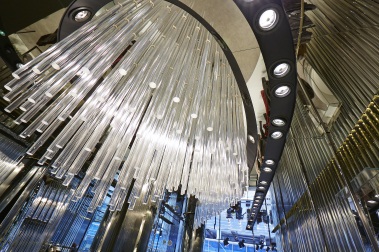When Into Lighting started to design a lighting scheme for the French fashion house Jitrois on London’s Sloane Street, it knew it had to come up with a model that was as elegant, individual and impeccably executed as the clothes it would be illuminating.
The designers behind the refurbishment - Paris-based architect Christophe Pillet and fashion designer Jean-Claude Jitrois - had a vision for the store’s lighting scheme that was completely LED. It’s a challenge that, so far, has seldom been achieved, largely because of cost. However the combination of several factors, including the location, type of retailer and increasing affordability of LEDs, meant Into was able to turn this vision into a reality and produce a watershed 100-per-cent LED design.
The store, on the prestigious Sloane Street, has formidable neighbours including Harvey Nichols, Cartier and Versace. Into director Russell Ford is the first to admit the brief was demanding, but said: “It was high-end retail and high-end fashion - it was important to get it right.”
The Into team soon saw they needed to rework the original brief so they took it and came up with a design that delivered on both concept and budget.
The brief stipulated an increase in light levels, illuminating the merchandise, and being very energy efficient. This had to be worked into a two-floor store, at ground level and basement, which had originally been lit with halogens, common in oldschool, high-end retail.

Reflective thinking
Finishes of black, acrylic and mirror were central to the design concept, but also central to Into’s challenge. With so many reflective surfaces, how could it design a lighting scheme that didn’t reveal its unsightly mechanics?
“We had to look at each and every detail,” said Ford. “We had to draw up a dimensions spec for each of the fittings.”
On the ground floor the main perimeter lighting for the clothes is provided by recessed, adjustable Photec AR111 LED gimbals set in a trough that runs throughout the store. The gimbals give a 20-degree beam of an 800 lumen warm white light, providing a tight beam and a low glare. Ford says he chose the AR111 LED because the final effect was similar to that of halogen, something he thought was in the vision of the architect John-Claude Jitrois who said he wanted to represent “the soft touch of candlelight on the skin”.
The store design includes floor-to-ceiling acrylic rods mounted on side walls. The original specification included more than 300 2.5W recessed downlights to illuminate every rod, but this simply wasn’t within budget. Into used a surface-mounted linear warm white LED tape - 2,700K from Photec - which distributed 14.4W/m in a concealed detail washing light through the rods to equally dramatic effect.
On other walls and ceilings there are numerous mirrored surfaces, as well as a gentle strip of reflected light that runs horizontally across the top of the wall at the sides of the store. Given the way the mirrors distort the actual boundaries of the store, this strip helps to create some definition between the walls and ceiling.
“We spent a lot of time making sketches and having site discussions about each linear detail to avoid unsightly reflections of the tape by using small upstands and considering viewing angles,” said Ford.
A huge acrylic drop-rod chandelier gives the store its wow-factor centrepiece. These rods are illuminated by LED modules that are fitted both in the ceiling and around the edge of the luminaire. “Adjustable fittings in an angled ceiling slot detail light through the rods to add a bit of sparkle,” Ford says when he explains the functionality of the showpiece.
Individual LED modules were mounted in a ceiling void to directly to shine on top of each rod.
“We couldn’t have a nice neat matrix, the LEDs were suspended on a curve. The challenge was getting the setting out right and using strings of LED modules with the right string spacing,” said Ford.
The LED lighting around the chandeliers had to be slightly dimmed once the luminaires were in place to avoid overpowering the rest of the store. Again, AR111 LED gimbals were used, this time with 45-degree lamps dimmed by a Mode slider for this circuit alone.

Changing moods
The candlelight mood extends into the changing rooms where AR111 LEDs were again used, complemented by a perimeter wash of light and a surface-mounted 2,700K linear led tape.
“We didn’t change the feel or temperature,” said Ford. “The lamp has this warmth and a good colour rendering index, which keeps it still quite muted despite the fact that it’s actually fairly well lit.”
Despite the challenges, according to Ford, high-end retail is the perfect place to experiment with LED lighting and is likely to be the forerunner as retail converts to LED. Unfortunately Into couldn’t use LEDs in the window display, something that will hopefully change in the near future.
“LED have just about come into the right price bracket and the first place you’re likely to see purely LED projects is highend retail. Traditionally, it has lower lighting and LEDs will be replaced where you still see halogen,” says Ford. “Most retail needs refitting in five years so, with LEDs, retailers didn’t get the payback. In the retail place it’s all about capital cost. The cost is making it possible.”
When it comes to trend setting, it seems the lighting industry looks to high-end retail to lead the way in much the same way it does in fashion.





